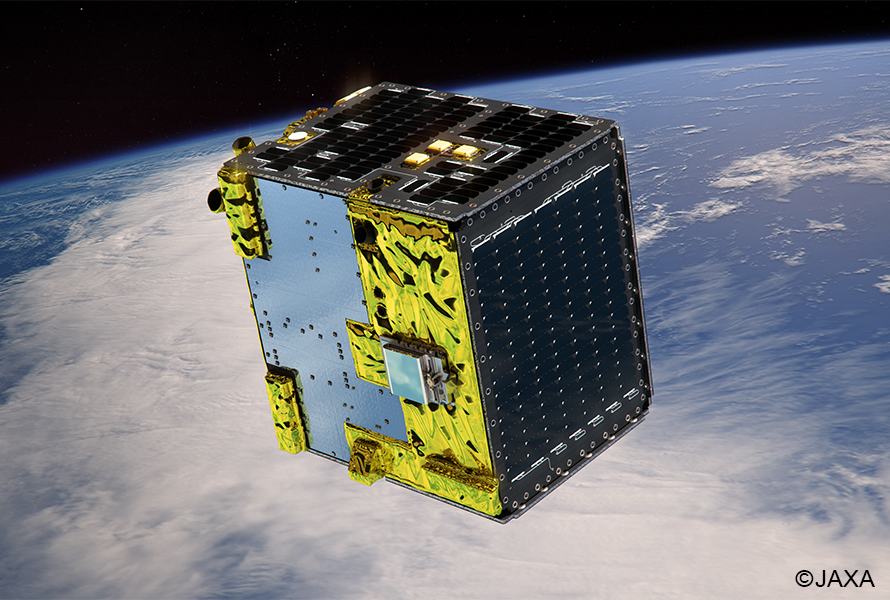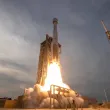Featured image credit: JAXA
Lift Off Time | November 9th, 2021 – 00:55 UTC | 09:55 JST |
|---|---|
Mission Name | RAISE-2 & Others |
Launch Provider | Japan Aerospace Exploration Agency (JAXA) |
Customer | Japan Aerospace Exploration Agency (JAXA) |
Rocket | Epsilon |
Launch Location | Mu Pad, Uchinoura Space Center, Japan |
Payload mass | 337 kg (743 Ib) |
Where are the satellites going? | 560 km Sun-Synchronous Orbit at a 97.6° inclination |
Will they be attempting to recover the first stage? | No, this is not a capability of Epsilon |
Where will the first stage land? | It will crash into the Pacific ocean |
Will they be attempting to recover the fairings? | No, this is not a capability of Epsilon |
Are these fairings new? | Yes |
How’s the weather looking? | TBD |
This will be the: | – 1st mission of JAXA in 2021 – 5th mission of the Epsilon rocket – 108th orbital launch attempt of 2021 |
Where to watch | First attempt Second attempt Third attempt |
What does all this mean?
Japan Aerospace Exploration Agency (JAXA) is preparing for its RAISE-2 & Others mission, which will deploy nine technology demonstration satellites into 560 km Sun-Synchronous Orbit (SSO), at a 97.6° inclination. The mission will be launching from the Mu Pad at the Uchinoura Space Center in Japan and will mark the fifth flight of the Epsilon rocket.
Initially, the liftoff was scheduled for October 1, 2021, at 00:51 UTC (9:51 JST). However, the launch was scrubbed due to a malfunction found in the ground station. The second attempt was scheduled for October 7, at 00:51 UTC (9:51 JST) but was scrubbed due to strong upper-level winds.
RAISE-2 & Others Mission
Payload
As a part of the second Innovative Satellite Technology Demonstration program, this rideshare mission will carry nine satellites into space. Among them are one smallsat (RAISE-2), four microsatellites (HIBARI, Z-Sat, DRUMS, TeikyoSat-4), and four CubeSats (ASTERISC, ARICA, NanoDragon, KOSEN-1).
RAISE-2
RAISE-2 (RApid Innovative payload demonstration Satellite-2) is a 75x100x100 cm smallsat with a mass of 110 kg (to better imagine the size, 100 cm is a length of a typical guitar). This satellite is developed, manufactured, and operated by Mitsubishi Electric Corporation. According to the press-release, it will test and provide experimental data from six new demonstration devices (3D-ANT, ASC, ATCD, I-FOG, MARIN, and SPR) hosted on the RAISE-2 that were selected by open recruitment.

HIBARI
HIBARI is a 59x59x55 cm microsatellite with a mass of 55 kg, developed by Tokyo Institute of Technology. This microsat will demonstrate a new attitude control technology, operation of the ultraviolet camera, and real-time communication.
Z-Sat
Z-Sat is another 50x50x51 cm microsat with a mass of 46 kg, developed by Mitsubishi Heavy Industries. This satellite will take images simultaneously at multiple wavelengths using its near-infrared and far-infrared cameras. By superimposing the acquired images, this technology will help to detect the position and temperature of heat sources more accurately. Overall, it will be one of the steps to develop an orbital constellation for monitoring terrestrial infrastructures.
DRUMS
DRUMS is the third microsat that will be launched on the RAISE-2 & Others rideshare mission. This 59x60x84 cm satellite with a mass of 62 kg was developed by Kawasaki Heavy Industries and will be used to demonstrate the debris removal technology in orbit. For that, a small target (debris) will be released, approached, and finally captured.
TeikyoSat-4
TeikyoSat-4 is a 55x55x55 micro satellite with a mass of 52 kg, developed by Teikyo University. It will test a new spacecraft bus platform capable of autonomously performing different experiments.
CubeSats: ASTERISC, ARICA, NanoDragon, KOSEN-1
ASTERISC (11x11x34 cm, 4 kg, Chiba Institute of Technology), ARICA (10x10x11 cm, 1 kg, Aoyama Gakuin University), NanoDragon (10x10x34 cm, 4 kg, Meisei), and KOSEN-1 (10x10x23 cm, 3 kg, National Institute of Technology) are the four CubeSats that will be launched on this mission.
ASTERISC features a large membrane-like dust sensor, which will be used for the observation of orbital dust particles. ARICA is a test satellite equipped with a gamma-ray detector for observation of celestial bodies. NanoDragon will test a new on-board computer for CubeSats (OBC). Finally, KOSEN-1 will test its OBC and radio wave receiving antenna to study Jupiter.
Mission’s Profile
Shortly after lift off, the rocket will roll to the launch azimuth angle of 121.4° and will fly over the Pacific Ocean. Its first, second, and third stages will separate at 2 min and 41 s, 6 min and 30 s, and 9 min and 54 s after launch, respectively. After that, the Post Boost Stage (PBS) will burn from about 16 min and 13 s to 18 min and 03 s and from about 42 min 17 s to 50 min and 54 s. Then, the three satellites (RAISE-2, TeikyoSat-4, and ASTERISC) will be deployed into orbit. This will be followed by the third burn of the PBS and deployment of the five other satellites (Z-Sat, DRUMS, HIBARI, KOSEN-1, ARICA, and NanoDragon).
Timeline
| Hrs:Min:Sec From Lift-Off | Events | Altitude, km |
| 00:00:00 | Lift-Off | 0 |
| + 00:01:48 | Stage 1 burn end | 73 |
| + 00:02:31 | Fairing separation | 121 |
| + 00:02:41 | Stage 1 separation | 130 |
| + 00:02:45 | Stage 2 burn start | 133 |
| + 00:04:54 | Stage 2 burn end | 212 |
| + 00:06:30 | Stage 2 separation | 241 |
| + 00:06:34 | Stage 3 burn start | 241 |
| + 00:08:02 | Stage 3 burn end | 234 |
| + 00:09:54 | Stage 3 separation | 239 |
| + 00:16:13 | 1st PBS burn start | 283 |
| + 00:18:03 | 1st PBS burn end | 301 |
| + 00:42:17 | 2nd PBS burn start | 559 |
| + 00:50:54 | 2nd PBS burn end | 571 |
| + 00:52:35 | RAISE-2 deployed | 570 |
| + 01:06:30 | TeikyoSat-4 deployed | 570 |
| + 01:06:53 | ASTERISC deployed | 570 |
| + 01:08:34 | 3rd PBS burn start | 572 |
| + 01:08:47 | 3rd PBS burn end | 572 |
| + 01:10:06 | Z-Sat deployed | 574 |
| + 01:10:29 | DRUMS deployed | 574 |
| + 01:10:52 | HIBARI deployed | 575 |
| + 01:11:15 | KOSEN-1 and ARICA deployed | 575 |
| + 01:11:38 | NanoDragon deployed | 576 |
Epsilon
Epsilon (also known as Advanced Solid Rocket) is a three-stage solid-fuel small-lift launch vehicle with an optional fourth stage, a successor to the M-V rocket. Its maiden flight took place on September 14, 2013. Since then, the rocket has launched four times (most recently in January 2019), all four launches were successful.
| First Stage | Second Stage | Third Stage | Fourth Stage | |
| Height, m | 11.7 | 4.0 | 2.2 | 2.8 |
| Outer Diameter, m | 2.6 | 2.6 | 1.4 | 2.0 |
| Solid Motor | SRB-A | M-35 | KM-V2c | PBS |
| Thrust, kN (lbf), vacuum | 2,350 (528,301) | 446 (100,265) | 100 (22,481) | 0.2 (45) |
| Specific Impulse (ISP), s, vacuum | 284 | 295 | 299 | 231 |
| Burning Time, s | 108 | 129 | 88 | 641 |
The Epsilon rocket is about 26 meters in height and 2.6 meters in diameter. It is capable of placing a 590 kg payload into SSO. Apart from the optional fourth stage (PBS), the rocket is equipped with the Epsilon Satellite Mount Structure and Epsilon Small Satellite Orbital Deployer systems for accurately inserting individual satellites into their respective orbits.

First Stage
All stages of the Epsilon rocket are expendable. As its first stage, Epsilon uses an existing SRB-A solid rocket booster that can be found on the H-IIA launch vehicle. This was done to reduce the cost per launch for this rocket. The first stage is 11.7 m in height and 2.6 m in diameter and is capable of producing 2,350 kN of thrust, with an ISP of 284 s.
A new version of the rocket called Epsilon S will use the first stage based on a strap-on booster for the H3 vehicle. Its maiden flight is planned in 2023.
Second and Third Stages
As its second and third stages, the Epsilon rocket uses existing upper stages of the M-V launch vehicle. The second stage can reach 446 kN of thrust in a vacuum, with an ISP of 295 s. The third stage, in turn, is capable of producing 100 kN of thrust in a vacuum, with an ISP of 299 s.
Optional Fourth Stage
The fourth stage, known as the Post Boost Stage or Compact Liquid Propulsion System, runs on hydrazine and has an ISP of 231 s in a vacuum. It can re-ignite several times to send multiple payloads into different individual orbits.
Fairing
The Epsilon launch vehicle features fairings with a height of 9.6 m, diameter of 2.6 m, and a mass of 700 kg.





